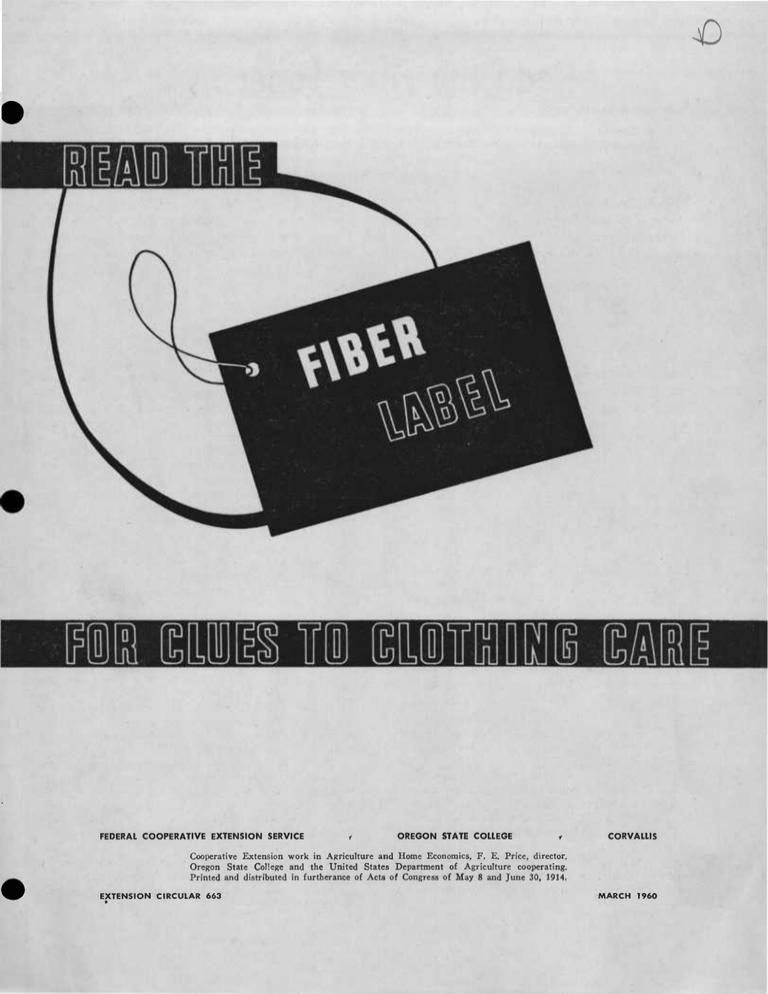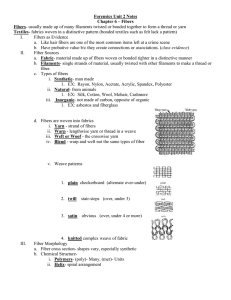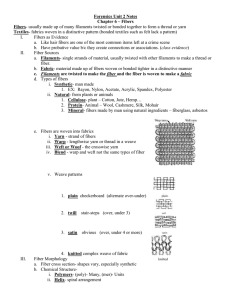JD
advertisement

JD FEDERAL COOPERATIVE EXTENSION SERVICE OREGON STATE COLLEGE CORVALLIS Cooperative Extension work in Agriculture and Home Economics, F. E. Price, director. Oregon State College and the United States Department of Agriculture cooperating. Printed and distributed in furtherance of Acts of Congress of May 8 and June 30, 1914. EXTENSION CIRCULAR 663 MARCH 1960 Read the Fiber Label MARY ROUTH Extension Clothing Specialist Oregon State College Fiber identification is an important clue to the use and care of modem fabrics. It is an aid to the consumer in selecting merchandise because textile fibers vary widely in their use and serviceability, and they react differently to care. Three fiber labeling acts have been passed by the Congress of the United States for consumer protection. The required label, if understood and used by the consumer, will give truthful information about merchandise and help to eliminate confusion about the multitude of fiber trademarks many of which represent the same basic fiber. Fiber Labeling Acts Generic names of fibers • Wool Products Labeling Act, oldest and most familiar of the labeling laws, has been in effect since July, 1941. It provides for mandatory fiber content labeling, by percentages, of all products containing wool, reprocessed wool, or reused wool fibers in any amount. Under the Act, fiber content labels must accompany woolen products from their raw fiber stage through the processes of manufacture and distribution until the end product reaches the purchaser-consumer. Each generic name, like a family name, identifies a dass of fibers. And, like members of a family, the fibers in a class covered by each generic name may differ widely in characteristics. But, stemming from one origin—either natural or manufactured—each class of fibers will respond to certain requirements for care. Some classes may be grouped by similar characteristics relating to care as shown in the table, page 3. The names of natural fibers—cotton, linen, silk, and wool—are familiar as are the generic names of some of the manufactured fibers like rayon and acetate. But, most of the manufactured fibers have unfamiliar generic names that will need to be learned. The generic name for each class of manufactured fibers identifies the fiberforming substance or chemical composition. • Fur Products Labeling Act, passed in 1951, prohibits the use of false, fictitious, and over-glamorized names for furs and fur products. Under this law every fur product must carry a label showing the true names of the animal that produced the fur, whether it is dyed, whether it is composed of pieces rather than a whole pelt, whether it is an imported fur and if so, its country of origin. In addition, the seller must provide a sales slip of invoice when a sale is made showing the same information. A consumer should insist upon labeled merchandise and obtain the sales slip—keep both for protection of the "truth-in-furs" purchase. • Textile Fiber Products Identification Act, effective March 3, 1960, requires fiber content labeling of all textile fiber products not required to be labeled under the Wool Act. The new Act covers articles of wearing apparel, costumes and accessories, draperies, floor coverings, furnishings, bedding, and other textile products which are of a type customarily used in a household. The required labels must contain the generic names and percentages by weight of the fibers in the product. In addition, the label must contain the name—or other registered identification—of the manufacturer of the product or other person or persons marketing or handling the product. Examples of Generic Classes of Fibers Cotton, long familiar, is a generic name covering a class of natural fibers which vary widely in length and quality of raw staple. The fine, long staple varieties (Egyptian and Pima) may be combed in processing to produce a fine, firm yarn and a fabric of smooth finish. Varieties of the short staple cotton fiber are processed without combing—but all varieties have quality characteristics for certain uses. Rayon, oldest of the manufactured fibers, is composed of regenerated cellulose derived principally from wood chips. There are some 45 trademarks for rayon fibers indicating variety in this class and wide differences of suitability for use; yet all are from the same origin and thus will be generically labeled "rayon." Acetate, like rayon, is dependent on cellulose for its basic raw material—but it differs from rayon by process of chemical production. It further differs in general use and in care, being more sensitive to heat and weaker when wet. Fiber trademarks paired with generic names There are many trademarks for the manufactured fibers. A manufacturer may use a fiber trademark if it is paired with the generic fiber name in equal size print the first time either appear on a label. There are many more trademarks than generic names, such as Acrilan, Orion, and Zefran which are trademarks of different manufacturers for the same generic fiber—Acrylic. Besides fiber trademarks there are trademarks for yam processes. Examples of these are Helanca for the stretch process, Ban-Lon for the bulk process, and Tycora for the textured effect process. Textile finishes also may be identified by trademarks. One example of a trademark for wash-and-wear finish is Regulated Cotton; for water-repellent, Cravenette; for stain-repellent, Scotchgard; and for shrinkage control. Sanforized. Voluntary information on labels Any information about performance and care on the label of a textile product will be voluntarily added by the manufacturer or merchant. Reliable manufacturers base performance claims and care recommendations on yarn construction, fabic weave or knit, textile finish, and finally, on garment design and trim in addition to the fiber content. Fabrics by the yard will be labeled as to fiber cotent, and consumers may look for performance and care information on textile yardage as well as ready-towear. Popular demand for such additional information may cause more of it to be furnished. The consumer will have to judge quality of a textile product based on knowledge, experience, and voluntary information furnished by manufacturers as to best uses of the product. To know the correct fiber content will be helpful in such judgment. Clues to clothing care The table on page 3 lists all of the generic names and examples of some fiber trademarks now used in clothing. Other trademarks may be found on labels and will be identified easily since they will be paired with the correct generic name. The table groups fibers by generic classes and gives general care requirements for each group. The consumer who becomes familiar with the generic names of fibers and learns to group certain classes will have the key to proper care of clothing. They are a clue to the right temperatures for washing, drying, and pressing—also to spot removal and storage of clothing. Thus they are useful to the homemaker, dry cleaner, and others concerned with maintaining lasting, good appearance of a wardrobe. The examples of fiber trademarks used in this publication are for the purpose of clarification only. No endorsement of products made from such fibers is intended, nor is criticism implied of other fiber trademarks not mentioned. Generic Name and Fiber Trademarks Clues to Clothing Care Based on Fiber Groups COTTON LINEN May be washed and ironed without special care. Avoid chlorine bleaches on resin finishes unless label states they are safe to use. RAYON *Coloray *Colorspun Cordura Cupioni Fortisan *Jetspun SILK Remove oily stains before washing resin finished fabrics; washing may set these stains permanently. Rayon needs more careful handling when wet than cotton and linen. Use cool temperatures for washing and pressing both fibers to prevent yellowing. To prevent felting of wool, use low agitation in washing machine and avoid rubbing when wet. WOOL ACETATE Acele ♦Celaperm *Chromspun Estron TRIACETATE Amel Require low temperature in drying and pressing. Water-borne stains can be wiped or washed off easily. Remove oily stains before washing; washing may set these stains permanently. Dissolved by acetone, paint remover, and fingernail polish remover. Sensitive to fading from atmospheric gases unless fibers are solution dyed. Triacetate can take higher pressing temperature than acetate. ACRYLIC Acrilan Creslan Orion MODACRYLIC Verel Dynel NYTRIL Darvan NYLON Caprolan Nylenka POLYESTER Require low temperature in drying and pressing. Water-borne stains can be wiped or washed off easily. Remove oily stains before washing; washing may set these stains permanently. Clothing requires little pressing; sweaters do not require blocking. Moth and mildew-resistant. Modacrylic most sensitive to heat. Press at very low heat. Nylon strongest and most durable. Dacron Kodel Teron Vycron RUBBER Lastex SPANDEX Lycra Vyrene Do not expose to excessive sunlight or heat; to oils, fats, or greases (lotions or creams). Wash frequently to remove body oils. Avoid constant overstretch, such as wearing the same girdle every day. * Indicates fiber is solution-dyed and thus highly resistant to fading.






